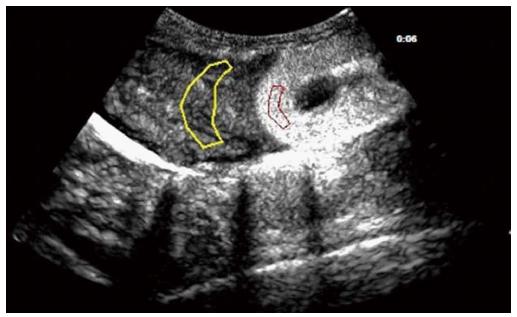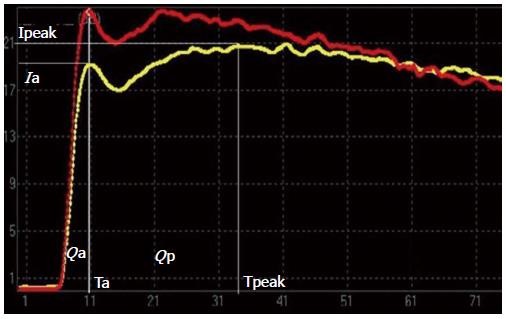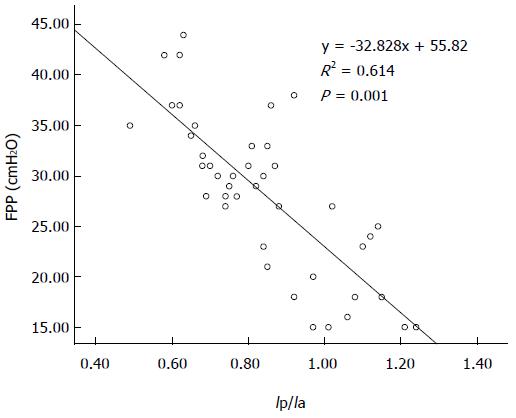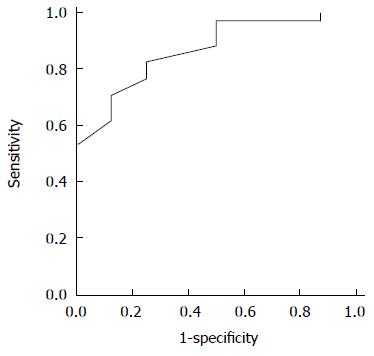Copyright
©The Author(s) 2015.
World J Gastroenterol. Apr 21, 2015; 21(15): 4509-4516
Published online Apr 21, 2015. doi: 10.3748/wjg.v21.i15.4509
Published online Apr 21, 2015. doi: 10.3748/wjg.v21.i15.4509
Figure 1 Contrast-enhanced ultrasonography of the right lobe of the liver and the upper pole of the kidney in a sagittal view.
The region defined in yellow is the region of interest (ROI) of the hepatic parenchyma, with the region in red being the ROI of the renal cortex.
Figure 2 Time-intensity curve of normal canine hepatic parenchyma and renal cortex in the liver-kidney section.
The red line represents the time-intensity curve (TIC) of the renal cortex and the yellow line represents the TIC of hepatic parenchyma. “Ta” represents the time at which renal intensity reaches the peak of the TIC. “Ia” represents the intensity at the time of Ta in the TIC of the hepatic parenchyma. Ipeak and Tpeak represent the maximum intensity of the TIC of the hepatic parenchyma and the time at which the TIC arrives at Ipeak, respectively. The area under the curve of portal venous time and the hepatic arterial time are expressed as Qp and Qa, respectively.
Figure 3 Time-intensity curves of the hepatic parenchyma and the renal cortex in the liver-kidney section of the canine model at 24 wk.
The red and yellow lines represent the time-intensity curves (TICs) of the hepatic parenchyma and the renal cortex, respectively, in a treated animal. Points on the curve are highlighted where the data for the parameters indicated were derived. “Ta” represents the time at which renal intensity reaches the peak of the TIC. “Ia” represents the intensity at the time of Ta in the TIC of the hepatic parenchyma. Ipeak and Tpeak represent the maximum intensity of the TIC of the hepatic parenchyma and the time at which the TIC arrives at Ipeak, respectively. The area under the curve of portal venous time and the hepatic arterial time are expressed as Qp and Qa, respectively. The proportion of hepatic arterial infusion increased, and Qp/Qa and Ip/Ia were reduced.
Figure 4 Relationship between the area under the curve of the portal venous phase/hepatic arterial phase (Qp/Qa) and free portal pressure in the canine model.
Free portal pressure measurements from model animals at all time points were plotted as a function of Qp/Qa in order to assess the relationship between the two parameters.
Figure 5 Relationship between the intensity of the portal venous phase/hepatic arterial phase (Ip/Ia) and free portal pressure in the canine model.
Free portal pressure measurements from model animals at all time points were plotted as a function of Ip/Ia in order to assess the relationship between the two parameters.
Figure 6 Receiver operating characteristic curve showing that the prediction of elevated portal pressure (free portal pressure ≥ 18 cmH2O) based on the area under the curve of the portal venous phase/hepatic arterial phase was 0.
866.
Figure 7 Receiver operating characteristic curve showing that the prediction of elevated portal pressure (free portal pressure ≥ 18 cmH2O) based on the intensity of the portal venous phase/hepatic arterial phase was 0.
895.
- Citation: Zhai L, Qiu LY, Zu Y, Yan Y, Ren XZ, Zhao JF, Liu YJ, Liu JB, Qian LX. Contrast-enhanced ultrasound for quantitative assessment of portal pressure in canine liver fibrosis. World J Gastroenterol 2015; 21(15): 4509-4516
- URL: https://www.wjgnet.com/1007-9327/full/v21/i15/4509.htm
- DOI: https://dx.doi.org/10.3748/wjg.v21.i15.4509















